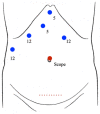Is Laparoscopic Hepatectomy Safe for Giant Liver Tumors? Proposal from a Single Institution for Totally Laparoscopic Hemihepatectomy Using an Anterior Approach for Giant Liver Tumors Larger Than 10 cm in Diameter
- PMID: 36354712
- PMCID: PMC9689527
- DOI: 10.3390/curroncol29110652
Is Laparoscopic Hepatectomy Safe for Giant Liver Tumors? Proposal from a Single Institution for Totally Laparoscopic Hemihepatectomy Using an Anterior Approach for Giant Liver Tumors Larger Than 10 cm in Diameter
Abstract
Background: The efficacy and safety of laparoscopic liver resections for liver tumors that are larger than 10 cm remain unclear. We developed a safe laparoscopic right hemihepatectomy for giant liver tumors using an anterior approach.
Methods: Eighty patients who underwent laparoscopic hemihepatectomy between January 2011 and December 2021 were divided into a nongiant tumor group (n = 65) and a giant tumor group (n = 15) for comparison.
Results: The median operating time, amount of blood loss, and length of postoperative hospital stay did not differ significantly between the nongiant and giant tumor groups. The sizes of the tumors and weights of the resected liver were significantly larger in the giant tumor group. A comparison between a nongiant group (n = 23) and a giant group (n = 12) treated with laparoscopic right hemihepatectomy showed similar results.
Conclusions: Laparoscopic hemihepatectomy, especially that performed on the right side, for giant tumors larger than 10 cm can be performed safely. Surgical techniques for giant liver tumors have been standardized, and their application is expected to spread widely in the future.
Keywords: anterior approach; giant liver tumor; laparoscopic hepatectomy.
Conflict of interest statement
The authors declare no conflict of interest.
Figures
Similar articles
-
Robotic, laparoscopic or open hemihepatectomy for giant liver haemangiomas over 10 cm in diameter.BMC Surg. 2020 May 6;20(1):93. doi: 10.1186/s12893-020-00760-5. BMC Surg. 2020. PMID: 32375738 Free PMC article.
-
Laparoscopic liver hanging maneuver through the retrohepatic tunnel on the right side of the inferior vena cava combined with a simple vascular occlusion technique for laparoscopic right hemihepatectomy.Surg Endosc. 2018 Jun;32(6):2932-2938. doi: 10.1007/s00464-017-6007-x. Epub 2017 Dec 21. Surg Endosc. 2018. PMID: 29270802 Free PMC article.
-
[The surgical technique of laparoscopic right hemihepatectomy. Technical aspects and results].Chirurg. 2014 Feb;85(2):139-46. doi: 10.1007/s00104-013-2672-z. Chirurg. 2014. PMID: 24435832 German.
-
World review of laparoscopic liver resection-2,804 patients.Ann Surg. 2009 Nov;250(5):831-41. doi: 10.1097/SLA.0b013e3181b0c4df. Ann Surg. 2009. PMID: 19801936 Review.
-
Liver Tumors.2019 May 4. LiverTox: Clinical and Research Information on Drug-Induced Liver Injury [Internet]. Bethesda (MD): National Institute of Diabetes and Digestive and Kidney Diseases; 2012–. 2019 May 4. LiverTox: Clinical and Research Information on Drug-Induced Liver Injury [Internet]. Bethesda (MD): National Institute of Diabetes and Digestive and Kidney Diseases; 2012–. PMID: 31689030 Free Books & Documents. Review. No abstract available.
Cited by
-
Risk-Adjusted Assessment of the Learning Curve for Pure Laparoscopic Donor Hepatectomy for Adult Recipients.World J Surg. 2023 Oct;47(10):2488-2498. doi: 10.1007/s00268-023-07089-z. Epub 2023 Jun 16. World J Surg. 2023. PMID: 37326677
-
Safety and Feasibility of Laparoscopic Parenchymal-Sparing Hepatectomy for Lesions with Proximity to Major Vessels in Posterosuperior Liver Segments 7 and 8.Cancers (Basel). 2023 Mar 30;15(7):2078. doi: 10.3390/cancers15072078. Cancers (Basel). 2023. PMID: 37046738 Free PMC article.
-
Effectiveness of pure laparoscopic right hepatectomy with a combined anterior and cranio-ventral approach for a giant hemangioma in a young woman.Clin J Gastroenterol. 2025 Jun;18(3):492-498. doi: 10.1007/s12328-025-02111-4. Epub 2025 Mar 19. Clin J Gastroenterol. 2025. PMID: 40106203
-
Robotic right hepatectomy via an anterior approach: technical considerations for managing large hepatocellular carcinomas.Updates Surg. 2025 Aug 9. doi: 10.1007/s13304-025-02353-4. Online ahead of print. Updates Surg. 2025. PMID: 40783673
References
-
- Gagner M., Rheault M., Dubuc J. Laparoscopic partial hepatectomy for liver tumor. Surg. Endosc. 1992;6:97–98.
-
- Makabe K., Nitta H., Takahara T., Hasegawa Y., Kanno S., Nishizuka S., Sasaki A., Wakabayashi G. Efficacy of occlusion of hepatic artery and risk of carbon dioxide gas embolism during laparoscopic hepatectomy in a pig model. J. Hepatobiliary Pancreat. Sci. 2014;21:592–598. doi: 10.1002/jhbp.103. - DOI - PubMed
-
- Kobayashi S., Honda G., Kurata M., Tadano S., Sakamoto K., Okuda Y., Abe K. An experimental study on the relationship among airway pressure, pneumoperitoneum pressure, and central venous pressure in pure laparoscopic hepatectomy. Ann. Surg. 2016;263:1159–1163. doi: 10.1097/SLA.0000000000001482. - DOI - PubMed
-
- Wakabayashi G., Cherqui D., Geller D.A., Buell J.F., Kaneko H., Han H.S., Asbun H., O’Rourke N., Tanabe M., Koffron A.J., et al. Recommendations for laparoscopic liver resection: A report from the second international consensus conference held in Morioka. Ann. Surg. 2018;268:11–18. - PubMed
MeSH terms
LinkOut - more resources
Full Text Sources
Medical




